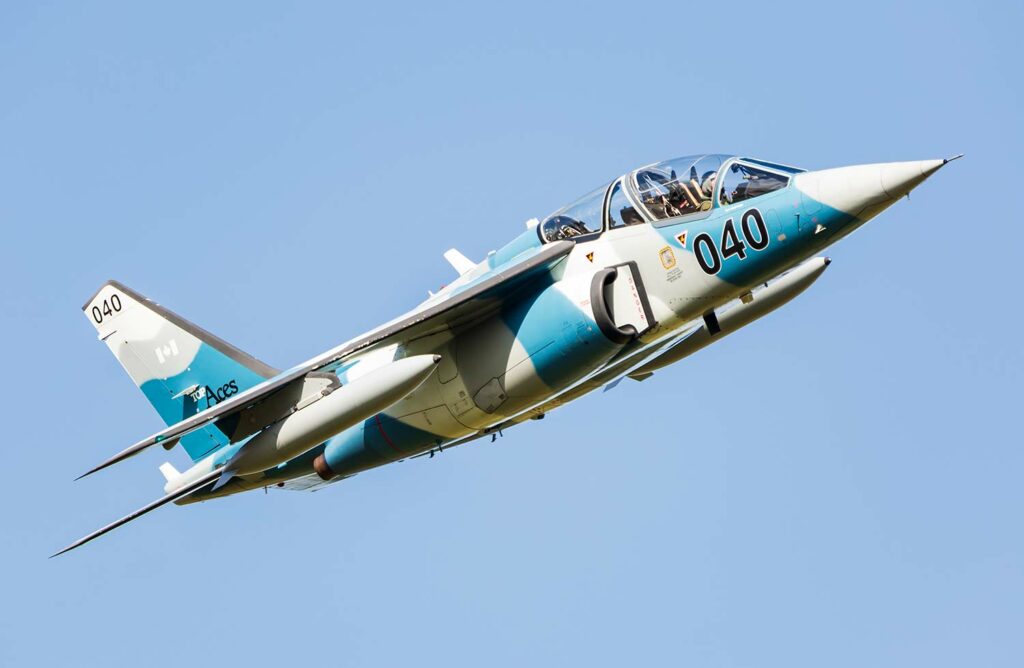Advanced jet trainer and light attack aircraft, dual-engine, high maneuverability.
In brief
The Dassault-Dornier Alpha Jet is a light attack jet and advanced trainer aircraft developed jointly by Dassault Aviation of France and Dornier GmbH of Germany. Introduced in the 1970s, it features a twin-engine design, optimized for both reliability and performance. The aircraft is capable of reaching speeds up to 620 mph (1,000 km/h) and has a service ceiling of 48,000 feet (14,630 meters). It is well-known for its agility, which is essential for its role in pilot training and light attack missions. The Alpha Jet is armed with a built-in cannon and can carry various ordnance on five hardpoints, making it versatile in combat and training scenarios.

History of the Development of the Dassault-Dornier Alpha Jet
In the late 1960s, European air forces recognized the need for a new generation of jet trainers to replace their aging fleets and to provide a platform capable of performing light attack duties. This requirement was driven by the increasing complexity of modern fighter jets, which necessitated a high-performance training aircraft that could also fulfill secondary combat roles. The collaboration between Dassault Aviation and Dornier GmbH was initiated under this premise, aiming to combine Dassault’s expertise in fighter jet design with Dornier’s experience in building robust and efficient aircraft.
The program was officially launched in the early 1970s, and the Alpha Jet prototype first took to the skies on October 26, 1973. This development was a direct response to NATO’s call for a new trainer that would meet the stringent demands of modern aerial combat and advanced flight training. The design and capabilities of the Alpha Jet were tailored to provide optimal training conditions while maintaining the performance characteristics of frontline fighters.
The Alpha Jet does not have a specific NATO nickname, which is consistent with many aircraft designed primarily for export and multinational use, focusing instead on its performance and adaptability to various air force requirements.
Design of the Dassault-Dornier Alpha Jet
The Alpha Jet’s airframe is constructed primarily from light alloys, featuring a semi-monocoque fuselage and a high-mounted wing configuration to enhance lift and maneuverability. The aircraft is 13 meters long with a wingspan of 9.11 meters (42.7 feet long with a wingspan of 29.9 feet). It is powered by two Larzac 04-C6 turbofan engines, each producing 2,900 pounds of thrust, which contribute to its top speed of 620 mph (1,000 km/h).
One of the distinctive features of the Alpha Jet is its excellent visibility from the tandem, stepped-up cockpit, crucial for training and light attack missions. It also features an advanced avionics suite for its era, including navigation and attack systems that can be updated to accommodate modern electronic warfare and countermeasures equipment.
However, while the aircraft’s design is optimized for agility and speed, its light armament capacity and limited range when fully equipped for combat missions are notable drawbacks. It was not designed to carry the heavy payloads of larger attack aircraft, which limits its effectiveness in prolonged or high-intensity combat scenarios.
Performance of the Dassault-Dornier Alpha Jet
The performance of the Alpha Jet is marked by its ability to reach a maximum speed of Mach 0.82 and a service ceiling of 48,000 feet (14,630 meters). Its range is approximately 620 miles (1,000 kilometers), but this can be extended with additional fuel tanks. The aircraft’s handling characteristics are highly rated, particularly its responsiveness and stability at various speeds and altitudes, which are critical for training new pilots.
When compared with competitors like the British Aerospace Hawk, the Alpha Jet holds its own in terms of speed and maneuverability, though it generally carries less ordnance. Its reliability and cost-effectiveness have made it a favored choice among several air forces for training purposes and secondary combat roles.
Variants of the Dassault-Dornier Alpha Jet
The Alpha Jet has been produced in several variants, primarily differentiated by their roles and avionic packages. The Alpha Jet A is the attack version, which has been used by several countries for close air support roles due to its capability to carry a variety of weapons. The Alpha Jet E is the advanced trainer variant, featuring specialized avionics for pilot instruction. Another notable variant is the Alpha Jet 2, an upgraded version with enhanced avionics and improved performance characteristics, tailored for export markets.

Military Use and Combat of the Dassault-Dornier Alpha Jet
The Alpha Jet has seen extensive service in various military roles beyond training. Its combat debut highlighted its capability as a light attack aircraft, supporting ground operations with conventional and precision-guided munitions. It has been employed in conflicts such as the Gulf War and in operations across Africa, where its agility and precision were advantageous in low-intensity conflicts and counter-insurgency operations.
The aircraft’s armament includes a built-in cannon (typically a 27mm or 30mm gun), and it can carry bombs, rockets, and missiles on its five hardpoints. This versatility has enabled it to fulfill a range of tactical missions, from air interdiction to direct ground support.
While newer, more advanced aircraft like the T-50 and M-346 have begun to replace the Alpha Jet in some air forces, several continue to use it due to its reliability and low operating costs. It remains in service in countries like France, Germany, and several African nations, though its role in frontline units has diminished with the arrival of more capable training and combat aircraft.
The Dassault-Dornier Alpha Jet has played a pivotal role in modern military aviation, particularly in training and light attack roles. Its development and operational use have demonstrated the value of versatility and adaptability in military aircraft design, continuing to serve as a reliable platform for pilot training and secondary combat roles across several air forces around the world.
Back to the Trainers section.